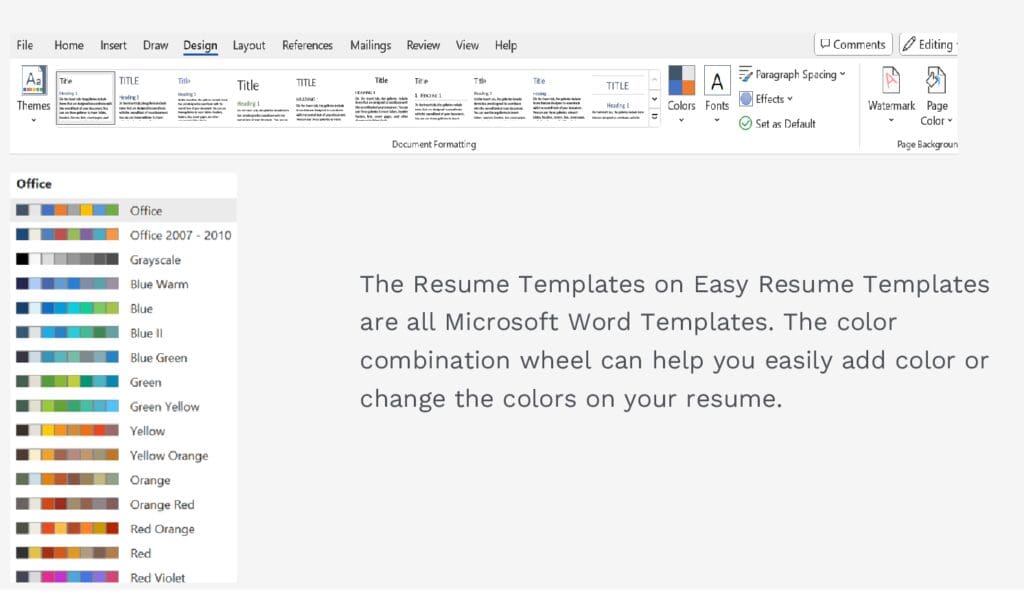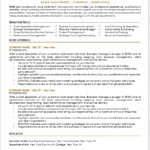Should You Use Color on Your Resume?

Author:
Staff Writer:
www.easyresumetemplates.com
Should You Use Color on Your Resume?
It used to be that pretty much all resumes were written in just the typical black and white text, devoid of any color. However, more and more job seekers are now adding pops of colors to their resumes. Is this hurting or helping them? In polling many of our staff recruiters the general consensus is that adding color to your resume can make your resume visually appealing and help your resume stand out from other candidates. Job seekers can use color on their resumes to quickly attract the attention of the hiring manager or recruiter. However, there’s a strategy to pulling it off in an effective manner. We’ll provide some tips and tricks to help you understand the pros and cons of adding color to your resume, how to add color, when it makes sense to include colors on your resume, and which job seekers should do it.
Who Should Use Color on Their Resume
Well technically, anyone can use color on their resume. However, adding color in a manner that will make your resume visually appealing is the tricky part. Research has shown that color increases attention, so using color strategically can direct the recruiter’s eye to the important information that you want to highlight. If not done correctly, your resume can come across as unprofessional, busy, hard to read, and
distracting. Whether or not you should add color to your resume depends on personal preference as well as the type of job or industry you’re in.
Creative Field: If you’re a job seeker focusing on creative positions you can add color to your resume to draw attention to areas of the resume that you want to highlight, and to demonstrate your artistic or design skills. Using color on your resume if you’re in any of the following job types or industries can help boost your visibility and success of being noticed by a recruiter or hiring manager.
Marketing and Advertising Professionals
Graphic Designers and Illustrators
Make-up-Artists
Web Developers
Interior Designers
Animators and Game Designers
Fashion Designers
Visual or Art Professionals
Photographers
Actors and Theatre Professionals
Journalists and Media Professionals
Musicians
Formal Industries: If you’re applying for a job in a more traditional or conventional industry colors can still be used sparingly. Having a colorful resume in these industries can be considered unprofessional and distracting, but it doesn’t have to be that way. Using a simple template that includes darker colors like navy blue, dark green, or burgundy is acceptable.
Which Colors are BEST to Use on Your Resume?
Determining which color combinations to use will depend a lot on your personal preference, how you’re hoping to express your individuality, and more importantly the industry you’re in. Here’s a general guideline that can be used to determine how to coordinate your colors.

The Psychology of Color
There’s also another factor to consider when deciding on the color scheme for your resume. How do you want the reader to feel when they view your resume? What impression do you want to make with your color selections? Ever heard of Color Psychology? Color Psychology is the study of hues and the effect on human behavior. Color psychology is widely used in marketing and branding. Think about Nike, Amazon, Target, Walmart, and many of the brands that you buy from. You recognize the brand by the logo and colors right? Your resume is your marketing and branding document, so the wise use of color may influence the emotions and perception of the recruiter or hiring manager. Bet you never even thought about that! There’s still a lot of research being done on the concept of color psychology, but we cannot disregard the emotions that certain colors evoke when we see them. When writing your resume and debating the use of color, consider color psychology when choosing colors or hues.
What the Colors on Your Resume Could Represent

Tips to Consider
Regardless of how much color you use on your resume, the most important thing is ensuring that the recruiter or hiring manager can still read your document-or that they WANT to read it.
- Use standard resume formatting to make sure that your resume is easy to read.
A standard formatting means you’re- Keeping your content left-aligned
- Using clear headings
- Using easy to read fonts (Calibri, Cambria, Helvitica)
- Using bullets to describe your experience.
- Have well defined resume sections
- Use colors that are high contrast and dark and make sure the body text on your resume is always black or dark gray to make it easy to scan
- Use a color scheme. Using a color scheme keeps your resume consistent and helps to guide the recruiter or hiring manager’s attention to the important parts of your resume that you might want to highlight. Let’s demonstrate how to use the colors.
- Choose a primary color for your header, and you can then keep this color consistent for the subheadings. Optionally, you can also select a bold color for the header, but then use a secondary color for your subheadings, such as Education, Skills, Work Experience sections of your resume.
- To keep your color scheme cohesive and appealing, you should use colors that complement each other well. A good practice is to stick with shades within the same color wheel if you want a pop of color, but you want to remain on the more traditional side. For example, use dark blue as a main color, then select lighter shades of blue for subheadings.
Microsoft Word Resume Templates and Colors
The Resume Templates on Easy Resume Templates are all Microsoft Word Templates, and if you click on the Design tab on the MS Word ribbon you will find a color wheel that can be helpful when trying to decide on a color scheme for your resume.

Coordinated Documents
It is also important to maintain a cohesive branded message across your resume, cover letter and follow-up thank you letter. Therefore, if your resume has color, use a coordinating cover letter, and follow up letter that maintains the same color scheme.
Yes, Add Color
In summary, using color elements when writing your resume can add more appeal and make your resume stand out. However, it’s important to make sure that you use color in a tasteful, skillful manner that makes your resume more attractive to the potential employer while highlighting your experiences and skills. Recruiters will also notice and appreciate a well-formatted traditional resume without color. Regardless of if you use color or black and white it’s also important to ensure that you allow enough white
space to increase the document’s readability and give the reader visual breaks.
Here are a few of our resume templates that show how color can be used.

Create Your Resume the EASY Way with a Template from
EASY RESUME TEMPLATES
Easy Resume Templates is committed to helping job seekers receive as much assistance as possible as they navigate the job search process. With our Team of Certified Resume Writers, Recruiters, and other HR professionals, we aim to provide expert knowledge, tips, and tools to help job seekers optimize their resumes and cover letters to not only get the interview, but land that job. Our team has significant years of experience within their specific fields and share their wisdom and knowledge to make the resume writing process easy and seamless. Let us help you land that job.
Our resumes are designed to make the resume writing process easy. With our wide selection of resume templates for just about anyone in any industry, at any career level, you will find a resume that makes sense for you.
When you use one of our templates, you are confident that you’re using a template that was created by experts to perform well with any ATS system. The templates are customizable and easy to use, and will allow you to create your resume in no time. You’ll be one step closer to getting your dream job.

Transform Your Resume in Minutes Using our EASY Resume Templates
